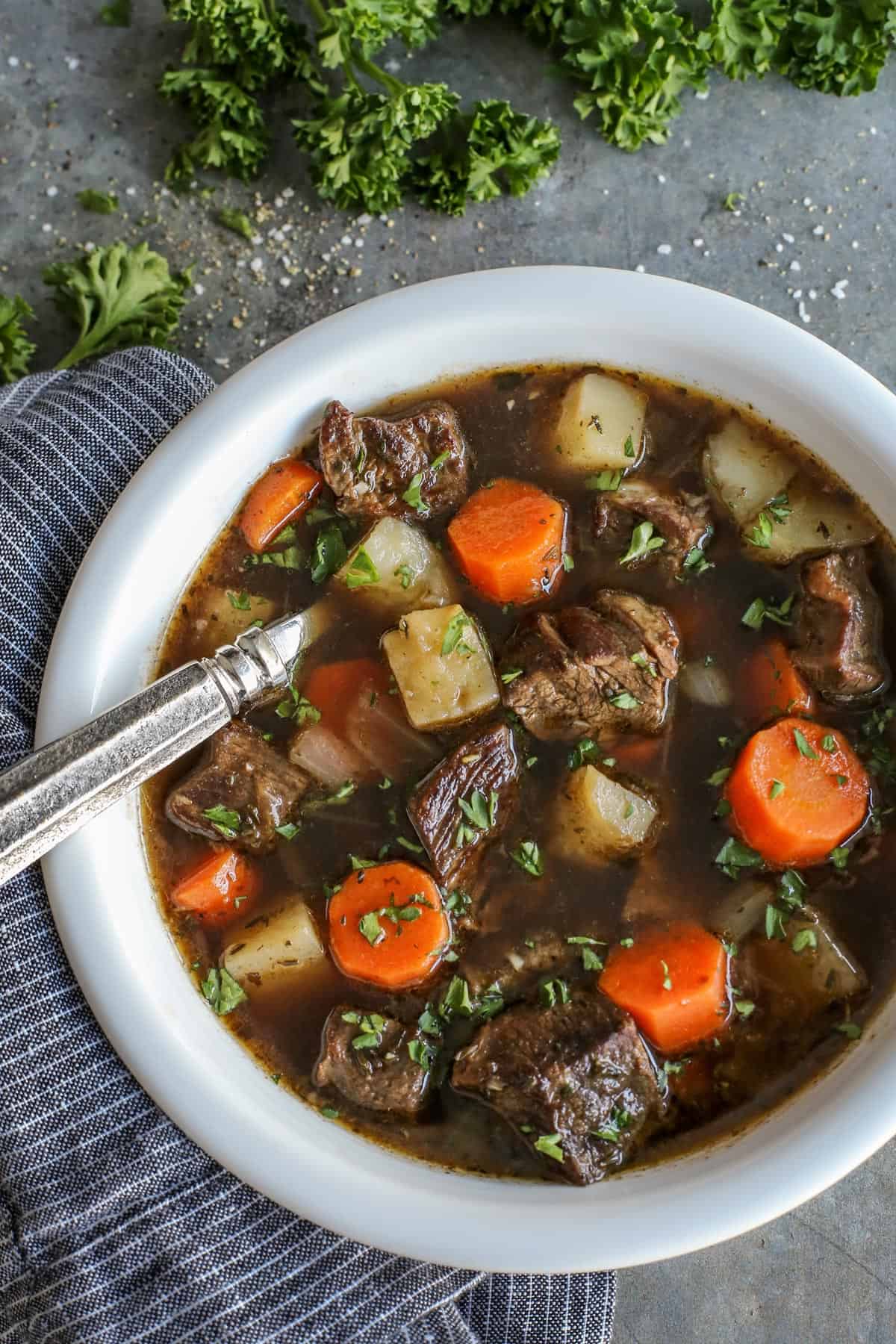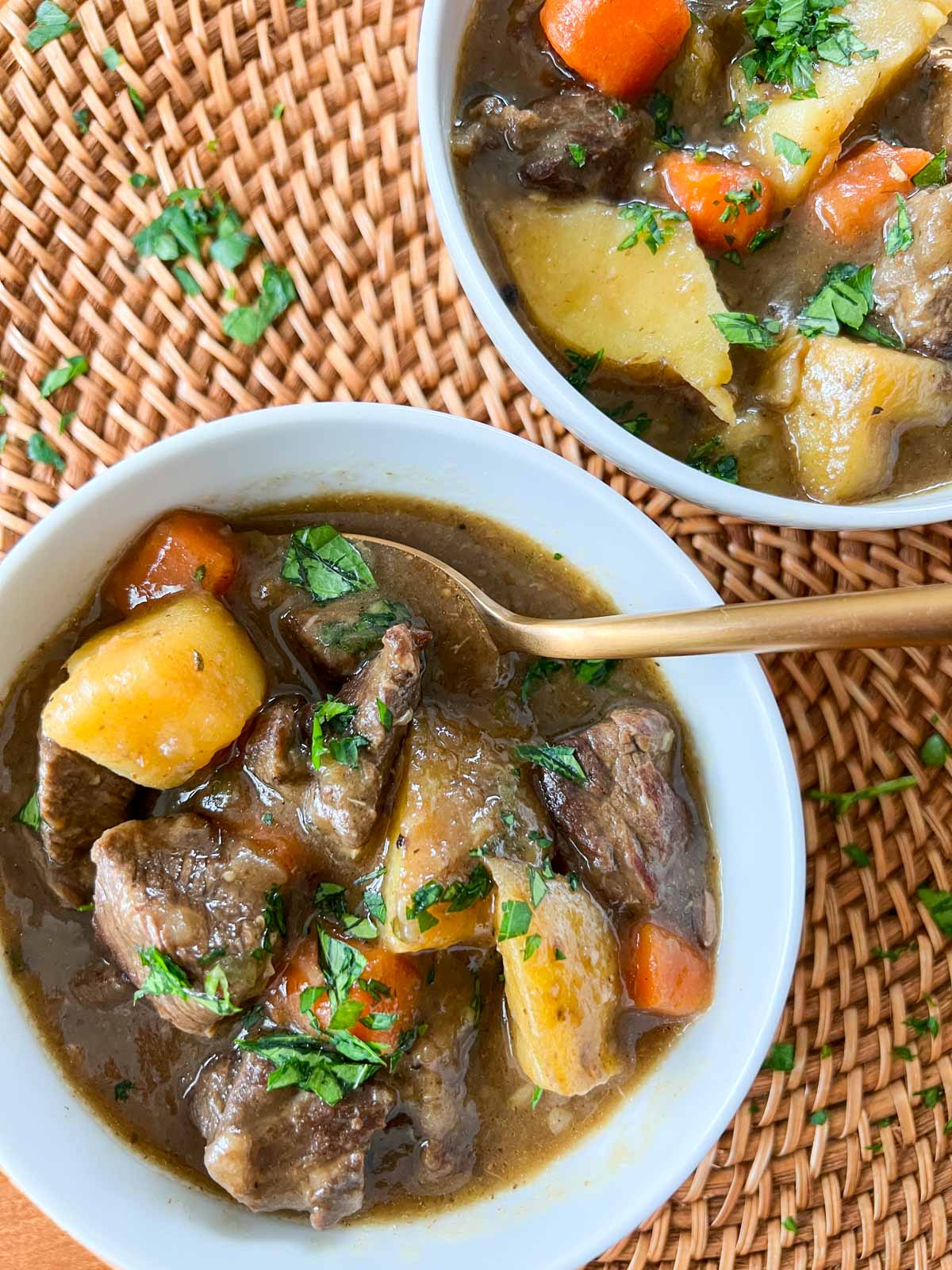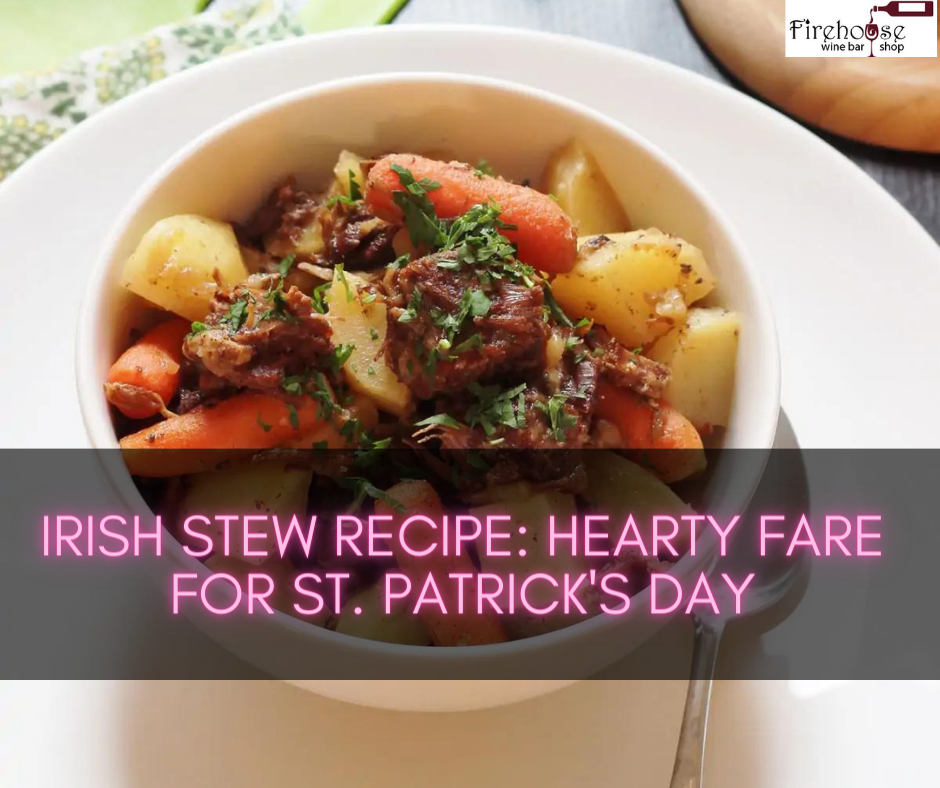Introduction

Irish Stew has long been a beloved dish that holds a special significance on St. Patrick’s Day. This hearty and flavorful stew is a staple in Irish cuisine and is known for its comforting and satisfying qualities. The stew’s warm and comforting flavors evoke nostalgia and tradition, making it the perfect dish to celebrate St. Patrick’s Day. In this article, we will explore the history of Irish Stew, delve into its ingredients and preparation, discuss traditional and modern variations, as well as provide tips for serving and presentation. Get ready to embrace the spirit of St. Patrick’s Day with this delicious Irish Stew recipe.
Background Of Irish Stew And Its Significance On St. Patrick’s Day
Irish Stew has a rich history deeply rooted in Irish culture and cuisine. It is believed to have originated in the 18th century in Ireland, where it quickly became a popular dish among the Irish people. The stew was traditionally made with affordable and readily available ingredients such as lamb or mutton, potatoes, onions, and carrots.
On St. Patrick’s Day, Irish Stew takes on a special significance as it embodies the spirit of the holiday and the flavors of traditional Irish cooking. It reminds us of the simple yet wholesome meals enjoyed by generations of Irish families. With its hearty and comforting qualities, Irish Stew perfectly complements the festive atmosphere of St. Patrick’s Day celebrations around the world.
You may want to read: Meatloaf Recipe: A Homestyle Favorite for Every Occasion
History Of Irish Stew Recipe
Irish Stew has a long and storied history in Irish cuisine. Its origins can be traced back to the 18th century in Ireland, where it quickly became a beloved dish among the Irish people. The stew was born out of necessity, making use of cheap and readily available ingredients such as lamb or mutton, potatoes, onions, and carrots. It was a hearty and filling meal that could sustain families in times of hardship. Over the years, Irish Stew has evolved and been adapted to suit different tastes and preferences, but its essence remains the same – a comforting and satisfying dish that speaks to the rich culinary heritage of Ireland.
Ingredients And Preparation

To make a traditional Irish stew, you will need a few simple and hearty ingredients. The key components include lamb or mutton, potatoes, onions, carrots, and parsley. These ingredients combine to create a flavorful and satisfying dish.
To prepare the stew, start by browning the meat in a large pot to enhance the flavors. Then, add the onions and cook until they are soft and translucent. Next, add the potatoes, carrots, and enough water or broth to cover the ingredients. Let the stew simmer for a couple of hours until the meat is tender, and the flavors meld together. Finally, garnish with fresh parsley and serve hot. Enjoy the comforting flavors of this classic Irish dish.
Key Ingredients For Irish Stew
The key ingredients for a traditional Irish Stew include lamb or mutton, potatoes, onions, carrots, and parsley. These elements come together to create a hearty and flavorful dish that has been enjoyed for generations. The use of lamb or mutton adds richness to the stew, while the potatoes and carrots provide substance and texture. The onions add a sweet and savory flavor, and the parsley adds a fresh and herbal note. Together, these ingredients create a dish that is both comforting and satisfying.
Step-by-step Guide To Preparing Irish Stew
- Start by heating a large, heavy-bottomed pot over medium-high heat and adding a splash of oil or butter.
- Once the pot is hot, add the chunks of meat (lamb or beef) and brown them on all sides for about 5-7 minutes. This will help to develop a rich flavor in the stew.
- Next, add the diced onions and cook until they are softened and translucent about 5 minutes. Stir occasionally to prevent burning.
- Now, it’s time to add the potatoes and carrots. Peel and chop them into chunky pieces, then add them to the pot. These vegetables will provide substance and texture to the stew.
- Pour in enough beef or vegetable stock to cover the ingredients. This will help to create a flavorful base for the stew. Bring the mixture to a boil, then reduce the heat to low and cover the pot.
- Let the stew simmer for about 1.5 to 2 hours or until the meat is tender and the flavors have melded together. Stir occasionally to prevent sticking.
- Finally, season the stew with salt, pepper, and chopped parsley to taste. This will enhance the flavors and add a fresh herbal note to the dish.
- Serve the Irish Stew hot in bowls, garnished with additional fresh parsley if desired. It pairs well with crusty bread for dipping and makes for a satisfying and comforting meal. Enjoy!
Traditional Vs. Modern Variations

When it comes to Irish Stew, both traditional and modern variations have emerged over the years.
Traditional Irish Stew follows the classic recipe with hearty chunks of meat, potatoes, carrots, and onions. It is a simple and flavorful dish that has been passed down through generations, capturing the essence of Irish cuisine.
On the other hand, modern variations of Irish Stew have started to incorporate unique ingredients and flavors to elevate the dish. Some variations include adding Guinness stout for a rich and robust taste or adding herbs and spices like thyme or rosemary to enhance flavor.
While the traditional recipe stays true to its roots, the modern variations offer exciting twists that cater to different tastes and preferences. Whether you prefer classic simplicity or adventurous flavors, Irish Stew continues to be a beloved dish that brings warmth and comfort to any occasion.
Traditional Irish Stew Recipe
Traditional Irish Stew is a beloved dish that captures the essence of Irish cuisine. This classic recipe is known for its simplicity and heartiness. To make traditional Irish Stew, you will need key ingredients such as chunks of tender lamb or beef, potatoes, carrots, and onions. The stew is slowly simmered to allow the flavors to meld together, resulting in a rich and flavorful dish. The combination of tender meat, soft potatoes, and vegetables creates a comforting and satisfying meal that is perfect for any occasion. Serve with a slice of crusty bread to mop up the delicious sauce and savor the taste of traditional Irish cuisine.
You may want to read: Pie Crust Recipe: The Foundation for Perfect Pies
Modern Twists And Variations Of Irish Stew
In recent years, chefs and home cooks have been putting their own unique spin on the traditional Irish Stew recipe. While the traditional version remains a favorite, there are some delicious modern variations to try. Some popular twists include adding Guinness beer for an extra depth of flavor, using lamb instead of beef for a more traditional taste, or adding a hint of international spices like curry or paprika to give the stew a global flair. Vegetarian and vegan versions of Irish Stew are also gaining popularity, replacing meat with hearty vegetables like mushrooms or lentils. Regardless of the variation you choose, these modern twists ensure that Irish Stew continues to delight taste buds around the world.
Serving And Presentation

Serving Irish Stew is a delightful experience showcasing the dish’s heartiness and flavors. To serve, ladle the stew into warm bowls, making sure to include a good portion of tender meat, potatoes, and vegetables in each serving. For an added touch, garnish with fresh parsley or thyme to enhance the visual appeal. To complete the presentation, accompany the stew with slices of crusty Irish soda bread or warm buttered rolls. The combination of the rich stew and the delectable bread creates a satisfying and comforting meal for St. Patrick’s Day or any occasion.
Best Practices For Serving Irish Stew
When serving Irish Stew, there are a few best practices to keep in mind. First, make sure to heat the bowls before serving to keep the stew warm for longer. Additionally, use a ladle to carefully portion out the stew into each bowl, ensuring that each serving has a generous portion of meat, potatoes, and vegetables. Garnish the stew with fresh parsley or thyme to enhance the flavors and visual appeal. Finally, serve the stew alongside slices of crusty Irish soda bread or warm buttered rolls for a complete and satisfying meal.
Garnishing And Presentation Tips
To enhance the visual appeal of your Irish Stew, consider garnishing it with fresh herbs such as parsley or thyme. Sprinkle a few chopped leaves on top of the stew before serving for a pop of color. Additionally, you can add a dollop of sour cream or a sprinkle of grated cheese on each serving to add creaminess and richness to the dish. Serve the stew in heated bowls to keep it warm for longer, and consider pairing it with slices of crusty Irish soda bread or warm buttered rolls for a complete and satisfying meal. By paying attention to the presentation of your Irish stew, you can elevate the dining experience and make it even more enjoyable for your family and guests.
Wine And Beer Pairings

When it comes to enjoying a delicious bowl of Irish Stew, choosing the right beverage to accompany it can enhance the overall dining experience. For wine lovers, a California Zinfandel pairs beautifully with the bold flavors of the stew. Zinfandels are known for their jammy fruit flavors and spicy notes, creating a harmonious balance with the hearty ingredients in the stew. Beer enthusiasts can opt for a traditional Irish stout, such as Guinness, which complements the rich and savory flavors of the dish. The roasted malt and coffee undertones of the stout provide a perfect match for the robustness of the stew. Whether you prefer wine or beer, these pairings will elevate your enjoyment of this classic Irish dish.
Recommended Wine Pairings For Irish Stew
When it comes to pairing wine with Irish Stew, opt for a dry red wine such as Cabernet Sauvignon or Merlot. These wines have bold flavors that can stand up to the richness of the stew, and their tannins help cut through the fat in the dish. The jammy fruit flavors and spicy notes of a California Zinfandel also make it a great choice to complement the hearty ingredients. These wine selections enhance the overall dining experience by creating a harmonious balance with the bold flavors of the Irish stew.
Best Beer Styles To Complement The Flavors Of Irish Stew
When it comes to pairing beer with Irish Stew, a few styles complement the rich and hearty flavors of the dish. A traditional Irish red ale is a great choice, with its malty sweetness and caramel notes providing a nice balance to the savory stew. Another option is a robust stout, such as a Guinness, which adds depth and roasted flavors to the meal. A refreshing Irish lager or a crisp pale ale can complement the dish if you prefer something lighter. Remember to serve the beer chilled to enhance the dining experience. Sláinte!
Conclusion
In conclusion, Irish Stew is a delicious and comforting dish that is perfect for celebrating St. Patrick’s Day or any time you crave a hearty meal. Its rich flavors, tender meat, and hearty vegetables make it a crowd-pleasing favorite. Whether you choose to follow the traditional recipe or put your own twist on it, Irish Stew is sure to please. Remember to pair it with a good wine or beer to enhance the flavors. With its simple ingredients and easy preparation, mastering the art of cooking Irish Stew will surely impress your family and friends. So, don’t hesitate to try this classic dish and enjoy the taste of Ireland in your own home. Sláinte!
Summarizing The Key Points Of Irish Stew Recipe
Irish Stew is a classic and comforting dish that combines tender chunks of meat, potatoes, and carrots in a flavorful broth. It is easy to make and perfect for celebrating St. Patrick’s Day or any time you crave a hearty meal. The traditional recipe calls for lamb, but you can also use beef or other protein options. The key to a delicious Irish Stew is slow cooking the ingredients to develop rich flavors. Don’t forget to serve it with some crusty bread or a side of mashed potatoes for a complete meal. Try your hand at cooking Irish Stew and enjoy the taste of Ireland in your own home.
Tips For Perfecting Your Irish Stew Cooking Skills
To perfect your Irish Stew cooking skills, some tips can elevate your dish to a whole new level. Firstly, choose good quality meat, whether it’s lamb, beef, or another protein option, as this will greatly impact the overall flavor. Secondly, browning the meat before adding it to the stew will enhance the richness and depth of the dish. Allowing the stew to simmer slowly and gently will also ensure that the flavors meld together beautifully. Lastly, taste and adjust the seasoning as needed, adding in herbs and spices to enhance the overall taste profile. With these tips, you’ll be able to create a truly delicious and authentic Irish Stew.
FAQ About Irish Stew Recipe: Hearty Fare For St. Patrick’s Day
Q: What is Irish Stew traditionally made of?
A: Traditional Irish Stew is made with lamb or beef, potatoes, carrots, onions, and sometimes other root vegetables like parsnips.
Q: Can I use a slow cooker for the Irish Stew recipe?
A: A slow cooker is a popular method for cooking Irish Stew. Simply brown the meat, sauté the vegetables, then add everything to the slow cooker and cook on low for 6-8 hours.
Q: How can I adjust the recipe for a vegetarian version?
A: You can make a vegetarian version of Irish Stew by replacing the meat with mushrooms or additional root vegetables. Use vegetable broth instead of beef broth for the base.
Q: Can I prepare Irish Stew in advance?
A: Yes, Irish Stew actually tastes better the next day as the flavors have more time to meld together. You can prepare it a day ahead and reheat it gently on the stove.
Q: Is it possible to freeze leftover Irish Stew?
A: Yes, Irish Stew freezes well. Once cooled, store it in airtight containers in the freezer for up to 3 months. Thaw in the refrigerator before reheating.
Q: What are some traditional sides to serve with Irish Stew?
A: Some traditional sides to serve with Irish Stew include soda bread, mashed potatoes, colcannon (mashed potatoes and cabbage), and a green salad to balance out the richness of the stew.
Q: Can I make a larger batch of Irish Stew for a crowd?
A: You can easily double or triple the ingredients to make a larger batch of Irish Stew for a crowd. Just make sure to use a large enough pot to accommodate the additional ingredients.

Andre Lotz immigrated to the United States from South Africa almost 20 years ago. Still, he didn’t feel truly at home until he settled in Mobile—a city that reminds him of his childhood home of Fish Hoek on the southern cape of Africa.

